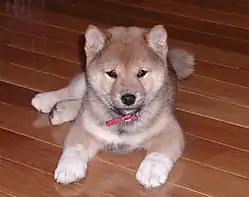柴犬
Japanese

柴犬 (shiba inu, shiba ken): a Shiba Inu puppy.
Etymology 1
| Kanji in this term | |
|---|---|
| 柴 | 犬 |
| しば Jinmeiyō |
いぬ Grade: 1 |
| kun’yomi | |
Compound of 柴 (shiba, “brushwood”) + 犬 (inu, “dog”),[1][2] possibly in reference to the dog's small stature and ability to pursue prey even through overgrown terrain.
Etymology 2
| Kanji in this term | |
|---|---|
| 柴 | 犬 |
| しば Jinmeiyō |
けん Grade: 1 |
| yutōyomi | |
Compound of 柴 (shiba, “brushwood”) + 犬 (ken, “dog”), using the on'yomi of ken for the second character.
Usage notes
The shiba inu reading appears to be more common.
References
- 1988, 国語大辞典(新装版) (Kokugo Dai Jiten, Revised Edition) (in Japanese), Tōkyō: Shogakukan
- 2006, 大辞林 (Daijirin), Third Edition (in Japanese), Tōkyō: Sanseidō, →ISBN
This article is issued from Wiktionary. The text is licensed under Creative Commons - Attribution - Sharealike. Additional terms may apply for the media files.